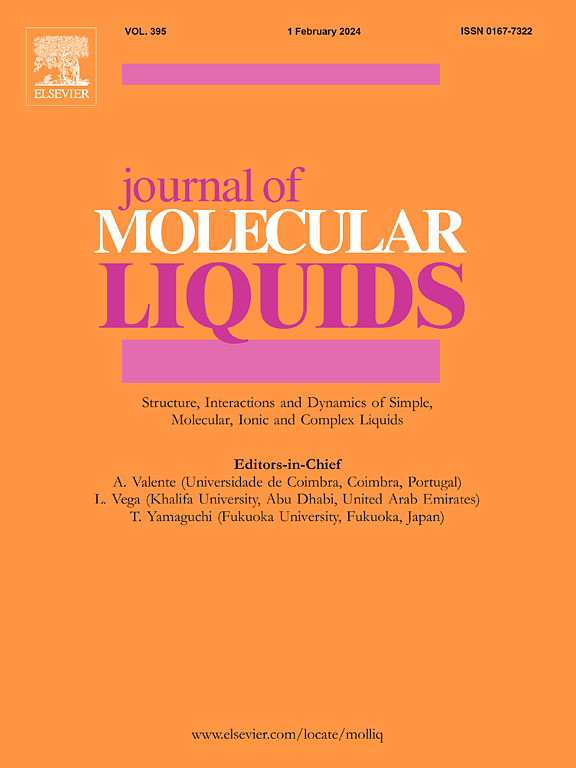Enhanced charge injection in quantum dot light-emitting diodes enabled by discotic liquid crystals
IF 5.3
2区 化学
Q2 CHEMISTRY, PHYSICAL
引用次数: 0
Abstract
Recent progress in quantum dot light-emitting diodes (QLEDs) has substantially improved their external quantum efficiency (EQE), nearing the theoretical limit of 25–30% for primary-color devices. Nevertheless, this peak performance is confined to low current densities and luminance levels, with a significant efficiency roll-off observed at elevated currents. This phenomenon has been primarily attributed to imbalanced charge carrier injection under high-current operation. While charge imbalance mitigation strategies hold critical importance, research on novel hole transport layer (HTL) materials addressing this issue remains relatively underexplored. Herein, we propose a discotic liquid crystals (DLCs) material, 2,3,6,7,10,11-hexabutoxytriphenylene (HAT-4), as an innovative HTL candidate for QLEDs. The HAT-4 system demonstrates enhanced hole mobility coupled with favorable energy level alignment for efficient hole injection into QD layers. However, its implementation is hindered by suboptimal film morphology characterized by excessive crystallinity. To address this limitation, we strategically introduced poly[(9,9-dioctylfluorenyl-2,7-diyl)-alt-(4,4′-(N-(4-butylphenyl))] (TFB) as a morphology-regulating agent. Notably, the optimized HAT-4/TFB (80:20 wt%) hybrid HTL enables remarkable device performance at 5 V, achieving 953 mA·cm−2 (2.2× enhancement vs. TFB control) and 380,000cd·m2 (2.1× improvement vs. TFB control), respectively. These breakthroughs substantiate the effectiveness of DLC-based hybrid HTLs in suppressing efficiency roll-off while achieving high brightness, thus providing a viable pathway toward high-performance QLED commercialization.
利用盘状液晶实现量子点发光二极管的增强电荷注入
量子点发光二极管(qled)的最新进展大大提高了其外部量子效率(EQE),接近原色器件25-30%的理论极限。然而,这种峰值性能仅限于低电流密度和亮度水平,在高电流下观察到显著的效率滚降。这种现象主要是由于在大电流下载流子注入不平衡造成的。虽然电荷不平衡缓解策略至关重要,但解决这一问题的新型空穴传输层(HTL)材料的研究仍然相对不足。在此,我们提出了一种圆盘状液晶(dlc)材料,2,3,6,7,10,11-六丁基三苯(HAT-4),作为qled的创新HTL候选材料。HAT-4系统增强了井眼迁移率,加上有利的能级对准,可以有效地注入QD层。然而,它的实施受阻于以过度结晶度为特征的次优薄膜形态。为了解决这一限制,我们战略性地引入了聚[(9,9-二辛基氟芴基-2,7-二基)-alt-(4,4 ' -(N-(4-丁基苯基))](TFB)作为形态调节剂。值得注意的是,优化后的chat -4/TFB (80:20 wt%)混合html在5 V下实现了卓越的器件性能,分别达到953 mA·cm - 2(比TFB控制提高2.2倍)和38万cd·m2(比TFB控制提高2.1倍)。这些突破证实了基于dlc的混合HTLs在实现高亮度的同时抑制效率滚降的有效性,从而为高性能QLED商业化提供了一条可行的途径。
本文章由计算机程序翻译,如有差异,请以英文原文为准。
求助全文
约1分钟内获得全文
求助全文
来源期刊

Journal of Molecular Liquids
化学-物理:原子、分子和化学物理
CiteScore
10.30
自引率
16.70%
发文量
2597
审稿时长
78 days
期刊介绍:
The journal includes papers in the following areas:
– Simple organic liquids and mixtures
– Ionic liquids
– Surfactant solutions (including micelles and vesicles) and liquid interfaces
– Colloidal solutions and nanoparticles
– Thermotropic and lyotropic liquid crystals
– Ferrofluids
– Water, aqueous solutions and other hydrogen-bonded liquids
– Lubricants, polymer solutions and melts
– Molten metals and salts
– Phase transitions and critical phenomena in liquids and confined fluids
– Self assembly in complex liquids.– Biomolecules in solution
The emphasis is on the molecular (or microscopic) understanding of particular liquids or liquid systems, especially concerning structure, dynamics and intermolecular forces. The experimental techniques used may include:
– Conventional spectroscopy (mid-IR and far-IR, Raman, NMR, etc.)
– Non-linear optics and time resolved spectroscopy (psec, fsec, asec, ISRS, etc.)
– Light scattering (Rayleigh, Brillouin, PCS, etc.)
– Dielectric relaxation
– X-ray and neutron scattering and diffraction.
Experimental studies, computer simulations (MD or MC) and analytical theory will be considered for publication; papers just reporting experimental results that do not contribute to the understanding of the fundamentals of molecular and ionic liquids will not be accepted. Only papers of a non-routine nature and advancing the field will be considered for publication.
 求助内容:
求助内容: 应助结果提醒方式:
应助结果提醒方式:


